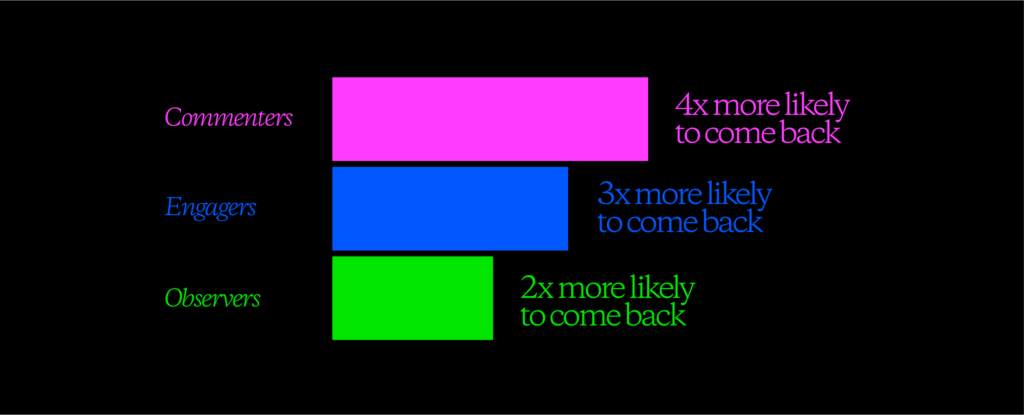OpenWeb works with legacy media brands like NYT, WSJ, and Forbes, and with newer companies like Refinery29, HuffPost and IGN, alike. This partner falls into the first camp—a household name looking to build a strong online business. This client had been active for nearly thirty years in print, and in that time they’d accumulated a large, loyal audience. They knew this audience was valuable, and they also knew its full potential was untapped. It seemed clear to them that, with the right strategy, they could increase loyalty and return users, and get them to comment on a wider array of content.
Our goal:
- Increase return visits
- More conversations across more articles
Like countless other media companies, they turned to social media to accomplish these goals. And just like many other companies, they found it to be a dead end. At every turn, their community-building efforts were thwarted by the changing algorithms and general chaos of life on the big platforms. Not to mention the fact that the community-building they did manage barely translated to activity on-site. In other words, they put in the work—but the social platforms got the reward.
It wasn’t until they turned to OpenWeb that they began to see real results.
OpenWeb’s commenting technology helped our partner garner 40,000 additional comments
Our partner had always hosted vibrant communities. Like many comments sections, though, theirs could often be unruly. Users inclined to comment might’ve stayed away, wary of getting involved in a contentious conversation.
This is why a well-moderated comments section is so important. The last thing you want an on-site community to do is alienate potential participants and sponsors/advertisers. In fact, it goes beyond potential participants, to anyone who might think to read the comments. Invariably, strife and invective repel readers and ad dollars, while measured, respectful conversation draws them in.
The end-result, in our partner’s case, is that our moderation technology helped generate over 40,000 additional comments. Those 40,000+ comments represent a dense, interconnected web of community activity—people joking around, debating (politely), providing their own unique spin on the day’s affairs.
Of course, user comments alone don’t make a community. For a publisher-owned community to work, users need to feel like there’s someone on the other side—like they’re not talking to each other in a void. To that end, OpenWeb’s Live Blog and Community Questions features helped open up the dialogue and keep the conversation flowing—both ways.
Active site users were 4X more likely to return with OpenWeb’s tech
It’s important to take a second to spell out why community matters so much for our partner’s outlet—really, for any outlet.
Between social platforms, streaming services, and rival publications, competition for eyeballs has never been fiercer. All of these media enterprises work tirelessly to keep users returning to their content over and over again. To stand out, publishers need to offer users something they can’t get elsewhere, something they feel endlessly drawn back to. Quality content is certainly one part of this equation, but community is just as important. In 2022, it’s the key to that most elusive and sought-after thing: retention.
The numbers here speak for themselves: in the period under discussion, users who commented on our partner’s articles were 4X more likely to come back the following week. And the numbers were just as stark for those who didn’t comment at all. Engagers—people who upvoted or downvoted a comment—were over 3X more likely to return, while those who merely observed the comments without engaging were more than twice as likely to return.

As those last two statistics indicate, the range of inputs monitored by OpenWeb is wide. A user doesn’t have to actually leave a comment to send a signal to a publisher about how their content is resonating. In our partner’s case and many others, we’ve helped synthesize those signals and translate them into actionable insights.
In the last few decades, thousands of websites have come and gone. Some can even still be visited––stuck in 1998, or 2006, or whenever it was they stopped publishing. But those that do last will almost certainly get there because they embraced the most potent force in publishing today—community.


